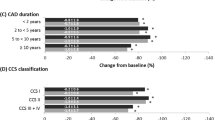Abstract
Objective: To compare the effect of two sustained-release formulations of metoprolol — metoprolol succinate controlled-release formulation with zero-order kinetics (M CR/Zok) and metoprolol tartrate conventional sustained-release formulation (M ret.) — on total ischaemic burden in patients with stable angina pectoris.
Patients and Methods: This randomised, double-blind, crossover study involved 52 patients with stable angina pectoris and at least six proven ST-segment depressions on 24-hour ambulatory ECG. After a 9-day placebo washout phase, patients were randomised to receive either M CR/Zok 95mg once daily for 4 weeks and then M ret. 200mg once daily for 4 weeks, or the same drugs in the reverse order. ST-segment parameters, cardiological and haemodynamic parameters were evaluated from 24-hour ambulatory ECG recordings.
Results: M CR/Zok and M ret. significantly reduced the median number of ischaemic episodes per 24 hours from 19.15 with placebo to 2.07 with M CR/Zok and 3.74 with M ret. For placebo, M CR/Zok and M ret., the total duration of ischaemia was 39.12, 2.58 and 4.42 minutes, respectively, and the maximum episode duration was 7.5, 1.0 and 1.0 minutes, respectively. The maximum ST-segment depression was 1.65mm with placebo and 1.10mm with M CR/Zok and M ret. The number of angina attacks per 30 days was reduced compared with the placebo phase, from a median of 10.0 to 2.14 with M CR/Zok and 2.68 with M ret. Correspondingly, the number of units of short-acting nitrates consumed fell from 6.67 to 2.14 with M CR/Zok and 2.18 with M ret. M CR/Zok and M ret. lowered the average heart rate from 80.0 to 69.0 and 72.0 beats/min, respectively. All these decreases were significant relative to placebo (p < 0.001), but (with the exception of heart rate) there was no significant difference between M CR/Zok and M ret. for any parameter. 19 patients experienced adverse events with placebo, 24 with M CR/Zok and 30 with M ret.
Conclusion: Our results show that M CR/Zok 95 mg/day or M ret. 200 mg/day taken once daily have similar efficacy on total ischaemic burden in patients with stable angina pectoris. M CR/Zok tends to be better tolerated.
Similar content being viewed by others
References
Gottlieb SO, Weisfeldt ML, Oryong P, et al. Silent ischemia predicts infarction and death during 2-year follow-up of unstable angina pectoris. J Am Coll Cardiol 1987; 10: 756–60
Selwyn AP, Raby K, Yeung A, et al. Orcadian rhythms and coronary events: implications for therapy. Cardiology 1992; 80 Suppl. 1:23–5
Portegies M, Sijbring P, Göbel E. Efficacy of metoprolol and diltiazem in treating silent myocardial ischemia. Am J Cardiol 1994; 74: 1095–8
Comerford MB, Basterman EM. A clinical evaluation of sustained release metoprolol durules in the treatment of angina pectoris. Clin Cardiol 1982; 5: 131–5
Abrahamsson B, Lücker P, Olofsson B, et al. The relationship between metoprolol plasma concentration and beta1-blockade in healthy subjects: a study on conventional metoprolol and metoprolol CR/ZOK formulations. J Clin Pharmacol 1990; 30:46–54
Egstrup K, Gundersen T, Härkönen R, et al. The antianginal efficacy of controlled-release metoprolol once daily: a comparison with conventional metoprolol tablets twice daily. Eur J Clin Pharmacol 1988; 33 Suppl.: S45–S49
Omvik P, Leer J, Istad H, et al. Equal efficacy and improved tolerability with 50mg controlled-release compared with 100mg conventional metoprolol in hypertensive patients. Am J Therapeutics 1994; 1: 65–73
Benesch L. Neue Metoprolol-Galenik ermöglicht Dosisreduzierung. Therapiewoche 1989; 41: 1103–6
Benfield P, Clissold SP, Brogden RN. Metoprolol: an updated review of its pharmacodynamic and pharmacokinetic properties and therapeutic efficacy in hypertension, ischaemic heart disease and related cardiovascular disorders. Drugs 1986; 31: 376–429
Kendall MJ, Maxwell SRJ, Sandberg A, et al. Controlled release metoprolol. Clinical pharmacokinetics and therapeutic implications. Clin Pharmacokinet 1991; 21: 319–30
Kleiger RE, Miller JP, Bigger Jr JT, et al. Decreased heart rate variability and its association with increased mortality after acute myocardial infarction. Am J Cardiol 1987; 59: 256–62
Schwartz PJ, La Rovere MT, Vanoli E. Autonomic nervous system and sudden cardiac death. Circulation 1992; 85 Suppl. I: 77–91
Gersch BJ, Braunwald E, Rutherford JD. Chronic coronary artery disease. In: Braunwald E, editor. Heart disease. Philadelphia: Saunders, 1997: S.1289–1365
The Task Force of the European Society of Cardiology. Guidelines — Management of stable angina pectoris. Eur Heart J 1997; 18: 394–413
Norwegian Study Group. Timolol induced reduction in mortality and reinfarction in patients surviving acute myocardial infarction. N Engl J Med 1981; 304: 801–7
Von Arnim T. Die stumme Myocardischämie. Berlin-Heidelberg: Springer, 1988
Gill JB, Cairns JA, Roberts RS, et al. Prognostic importance of myocardial ischemia detected by ambulatory monitoring early after acute myocardial infarction. N Engl J Med 1996; 334: 65–70
Von Arnim T. Prognostic significance of transient ischemic episodes: response to treatment shows improved prognosis. Results of the Total Ischemic Burden Bisoprolol Study (TIBBS) follow-up. J Am Coll Cardiol 1996; 28: 20–4
Pepine CJ, Cohn PF, Deedwania PC. Effects of treatment on outcome in mildly symptomatic patients with ischemia during daily life: the Atenolol Silent Ischemia Study (ASIST). Circulation 1994; 90: 762–8
Author information
Authors and Affiliations
Rights and permissions
About this article
Cite this article
Bongers, V., Sabin, G.V. Comparison of the Effect of Two Metoprolol Formulations on Total Ischaemic Burden. Clin. Drug Investig. 17, 103–110 (1999). https://doi.org/10.2165/00044011-199917020-00004
Published:
Issue Date:
DOI: https://doi.org/10.2165/00044011-199917020-00004




